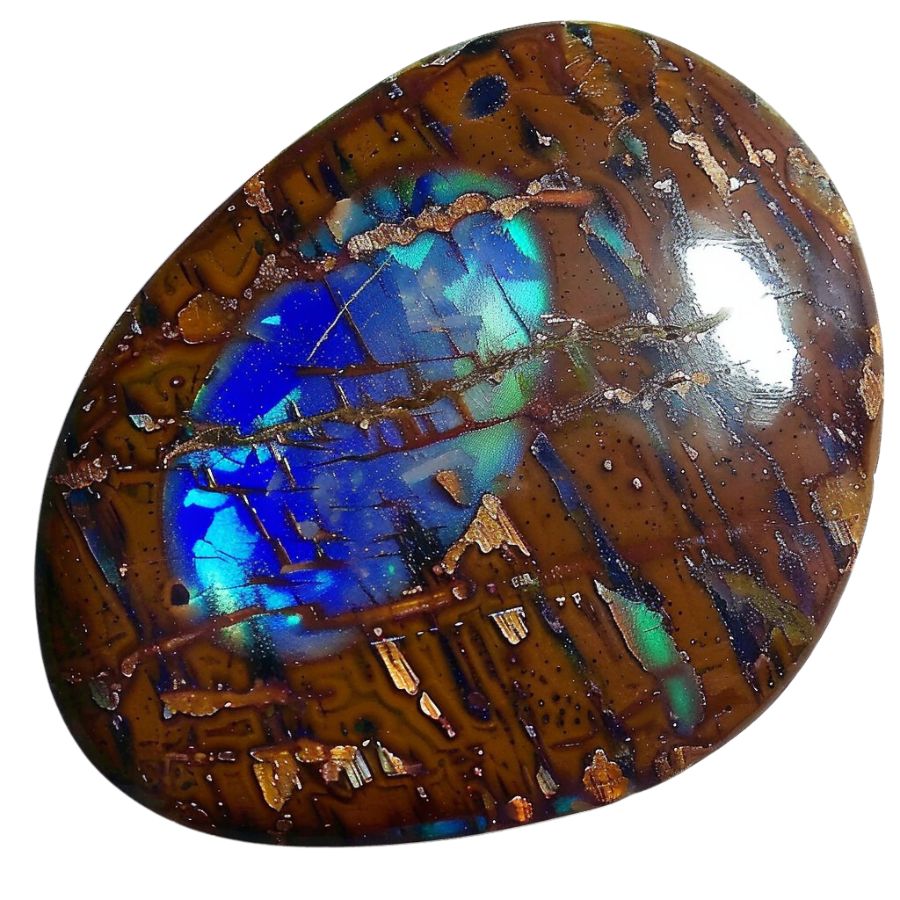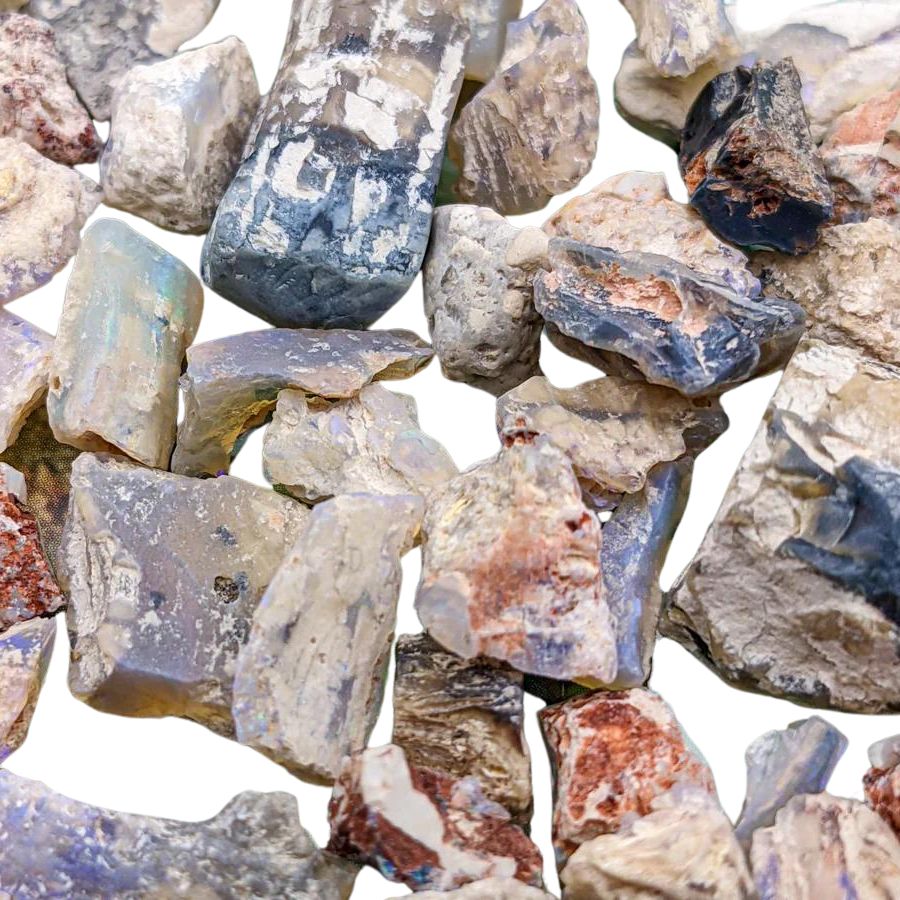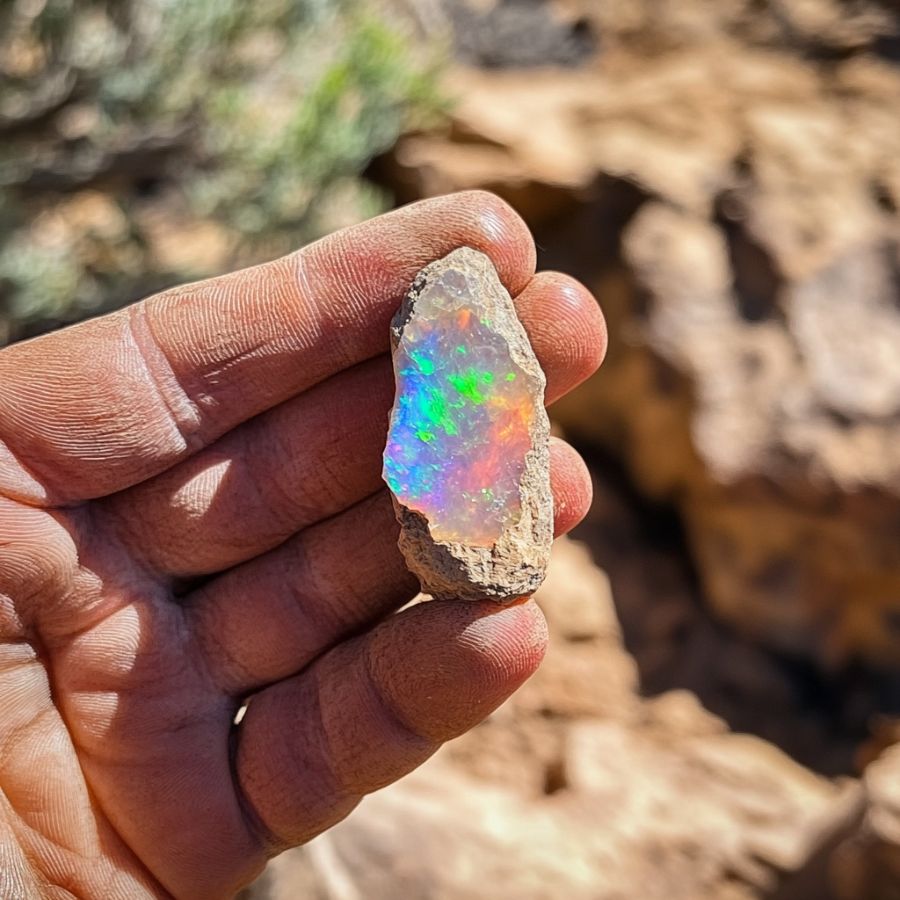From the rolling hills of Ohio to the Appalachian Mountains, from the Potomac River shared with Maryland to the coal-rich lands touching Kentucky, West Virginia’s diverse landscape holds hidden treasures.
If you are looking for opals in West Virginia, get ready. We’ve done the legwork for you. Today, we’ll show you the top 5 spots to find opals in West Virginia.
Save time and energy by focusing your search on these carefully selected locations. Get ready to explore the best opal hunting grounds the state has to offer!
How Opal Forms Here
Opal forms here through a fascinating natural process. When water containing silica seeps into cracks and voids in rocks, it begins to evaporate, leaving behind tiny silica spheres.
Over time, these spheres stack in a grid-like pattern, creating opal. This process can take millions of years!
The colors in opal come from the way light refracts through the silica spheres. Different conditions in the ground, like the type of rock and the presence of other minerals, can affect the opal’s type, color, and quality.
The Types Of Opal
There are several incredible types of Opal that can be found in the US as well as in our state. Each is uniquely beautiful and interesting including:

Common Opal
Common opal, also known as “potch,” stands out from other types of opal due to its lack of play-of-color, the iridescent display seen in precious opal. Instead, common opal features consistent, solid colors like white, pink, yellow, green, and blue.
It typically has a waxy to pearly luster and ranges from opaque to translucent. To identify common opal, look for its uniform color and absence of the shimmering color flashes found in precious opal.
Common opal forms under similar geological conditions as other opals, where silica-rich water seeps into rock cavities and slowly hardens over time. This process usually occurs in areas with volcanic activity or hot springs, where silica deposits are prevalent.

Fire Opal
Fire opal is known for its warm, vibrant colors, ranging from yellow and orange to deep red. Unlike precious opal, fire opal may or may not display the play-of-color, but its fiery body color makes it unique.
To identify fire opal, look for its bright, translucent to transparent appearance and the absence or presence of play-of-color within the warm hues.
Fire opal forms in volcanic regions where water rich in silica interacts with hot lava, filling cavities and fractures within the rock. Over time, the silica solution hardens, creating opal.
Visually, fire opal’s appeal lies in its vivid, flame-like colors that can be either uniform or exhibit internal flashes of color.

Boulder Opal
Boulder opal forms within the ironstone boulders of its host rock. Unlike other opals, boulder opal features precious opal veins intertwined with the natural rock, creating a beautiful contrast.
This opal is distinguished by its combination of colorful opal patches and the surrounding matrix, which can include ironstone or sandstone. To identify boulder opal, look for its vibrant play-of-color within the darker host rock, often showcasing brilliant blues, greens, and reds.
Boulder opal forms in sedimentary environments where silica-rich water infiltrates cracks and voids within ironstone or sandstone boulders. Over time, the silica hardens into opal, often creating thin seams or patches within the rock.

Hyalite Opal
Hyalite opal, also known as water opal, is a transparent to translucent type of opal that is distinctive for its glass-like appearance and lack of play-of-color. Unlike precious opal, which displays a rainbow-like iridescence.
You can identify hyalite opal by its clear to milky appearance, often with a slight green or blue fluorescence under UV light.
Hyalite opal forms in low-temperature hydrothermal environments, typically in volcanic regions. It precipitates from silica-rich fluids that fill cracks and voids in the host rock. This process can occur relatively quickly compared to other opal types.
Visually, hyalite opal resembles droplets of water or glass, often appearing as smooth, botryoidal (grape-like) formations. Its transparent nature makes it unique among opals, and its slight fluorescence adds to its allure.

Black Opal
Black opal is a rare and highly prized variety known for its dark body tone, which enhances the vibrant play-of-color. Unlike other opals, black opal has a deep background color, ranging from dark gray to jet black, making the iridescent colors more striking.
To identify black opal, look for its intense, dark base color coupled with brilliant flashes of blues, greens, reds, and other hues.
The presence of iron and carbon contributes to its dark body color. In the United States, black opal is primarily found in the Virgin Valley of Nevada, known for its rich opal deposits.

Crystal Opal
Crystal opal is known for its transparent to translucent body, which allows the play-of-color to shine through brilliantly. Unlike common opal, which is opaque, crystal opal’s clear or semi-clear nature enhances its vibrant internal colors.
To identify crystal opal, look for its see-through quality combined with flashes of color that can include blues, greens, reds, and more.
Its unique transparency sets crystal opal apart, making it a favorite among gem enthusiasts and collectors for its ethereal beauty.

Wood Opal (Opalized Wood)
Opalized wood is a fascinating form of petrified wood where the organic material has been replaced by opal. Unlike other opals, opalized wood retains the original structure and texture of the wood, creating a unique blend of organic and mineral elements.
To identify opalized wood, look for its wood grain patterns and opalescent sheen, often displaying a range of colors from white and brown to vibrant reds and greens.
Opalized wood forms under specific conditions where wood is buried in silica-rich sediment. Over millions of years, the silica solution gradually replaces the organic wood material with opal, preserving the wood’s original structure in stunning detail.

Contra Luz Opal
Contra Luz opal reveals its vibrant play-of-color when illuminated from behind. Unlike other opals, which display their colors through surface reflection, contra luz opal’s brilliance comes to life with transmitted light.
To identify contra luz opal, hold the gem against a light source and observe the internal flashes of color, which can include vivid reds, blues, greens, and purples.
This opal forms in volcanic environments where silica-rich water infiltrates cracks and cavities in the host rock. As the water evaporates, it leaves behind silica deposits that eventually solidify into opal.
Visually, contra luz opal appears nearly clear or milky when viewed without backlighting. However, when backlit, it displays stunning, colorful patterns that seem to glow from within.
What Rough Opal Looks Like
When you’re out looking for rough opal on your own it’s important to know what you’re looking for.
If you want REAL results finding incredible rocks and minerals you need one of these 👇👇👇
Finding the coolest rocks in isn’t luck, it's knowing what to look for. Thousands of your fellow rock hunters are already carrying Rock Chasing field guides. Maybe it's time you joined the community.
Lightweight, mud-proof, and packed with clear photos, it’s become the go-to tool for anyone interested discovering what’s hidden under our red dirt and what they've already found.
Join them, and make your next rockhounding trip actually pay off.
What makes it different:
- 📍 Find and identify 140 incredible crystals, rocks, gemstones, minerals, and geodes across the USA
- 🚙 Field-tested across America's rivers, ranchlands, mountains, and roadcuts
- 📘 Heavy duty laminated pages resist dust, sweat, and water
- 🧠 Zero fluff — just clear visuals and straight-to-the-point info
- ⭐ Rated 4.8★ by real collectors who actually use it in the field
This is what you need to look out for:
Look for exteriors like this

Look for play-of-color

Opal can display a range of colors, but what sets precious opal apart is its play-of-color—vivid flashes of multiple colors that change with the angle of light. Even in rough form, you might see hints of these colors peeking through.
Common opal lacks this feature and typically appears as a solid color like white, blue, or pink.
Check for a glassy or waxy luster

Opal often has a distinctive glassy or waxy luster. When you find a potential opal, examine its surface.
It should look shiny and smooth, almost like glass, even if it is still encased in a matrix or rough exterior.
Assess the density and weight

Opal is generally lighter than rocks of a similar size. When you pick up a piece of rough opal, it should feel lighter than expected.
Additionally, opal is relatively soft, with a Mohs hardness of 5.5 to 6.5, so it can be scratched more easily than quartz or other harder minerals.
A Quick Request About Collecting
Always Confirm Access and Collection Rules!
Before heading out to any of the locations on our list you need to confirm access requirements and collection rules for both public and private locations directly with the location. We haven’t personally verified every location and the access requirements and collection rules often change without notice.
Many of the locations we mention will not allow collecting but are still great places for those who love to find beautiful rocks and minerals in the wild without keeping them. We also can’t guarantee you will find anything in these locations since they are constantly changing.
Always get updated information directly from the source ahead of time to ensure responsible rockhounding. If you want even more current options it’s always a good idea to contact local rock and mineral clubs and groups
Tips on where to look
Once you get to the places we have listed below there are some things you should keep in mind when you’re searching:
Search in Sedimentary Rock Formations

Opal can also form in sedimentary rock formations where silica deposits have accumulated over time.
Focus on areas with ancient lake beds or clay deposits, as these environments are conducive to opal formation.
Check Dry Creek Beds and Gullies

Dry creek beds and gullies can be excellent places to find opal, as water flow can erode and expose opal-bearing rocks.
Look for exposed rock and gravel in these areas, especially after rainfall or seasonal flooding.
Investigate Old Mining Sites

Abandoned or historical mining sites can be rich in opal and other minerals. These areas often have tailings and discarded rock that may still contain opal.
Always seek permission if the land is privately owned and follow safety guidelines.
Look for Indicator Minerals

Certain minerals can indicate the presence of opal. Look for rocks and soil containing ironstone, sandstone, or clay, as these materials often coexist with opal deposits.
Additionally, finding quartz or chalcedony can suggest nearby opal.
The types of Opal can you find around the state
West Virginia is home to several types of opal, especially wood opal and deep yellow opal.
Wood opal, also known as opalized wood, is a type of opal that forms when wood is replaced by opaline silica. This process preserves the original wood structure, resulting in a unique gemstone with a distinct grain pattern.
Deep yellow opal, on the other hand, is a rare variety of opal that displays a rich, golden hue. These opals are often found in sandstone deposits and conglomerates containing white quartz.
Some Great Places To Start
Here are several excellent locations within West Virginia where you can begin your search for opals. These spots are among the top choices for finding what you need.
Always Confirm Access and Collection Rules!
Before heading out to any of the locations on our list you need to confirm access requirements and collection rules for both public and private locations directly with the location. We haven’t personally verified every location and the access requirements and collection rules often change without notice.
Many of the locations we mention will not allow collecting but are still great places for those who love to find beautiful rocks and minerals in the wild without keeping them. We also can’t guarantee you will find anything in these locations since they are constantly changing.
Always get updated information directly from the source ahead of time to ensure responsible rockhounding. If you want even more current options it’s always a good idea to contact local rock and mineral clubs and groups
Coopers Rock

Coopers Rock is a stunning state forest located in the northeastern part of West Virginia, about 13 miles east of Morgantown.
This area is renowned for its dramatic sandstone cliffs and lush forests, making it a prime spot for nature lovers and rockhounding enthusiasts alike. Notably, opals have been discovered here, particularly in the Pottsville sandstone formations.
The forest features the Cheat River Gorge, where the river has carved out beautiful landscapes, providing excellent locations for finding gemstones.
Rockhounds should explore the gravels and rocky outcrops near the cliffs and along the riverbanks, where glacial deposits might reveal hidden treasures.
Cassville

Nestled along the banks of the Monongahela River in Monongalia County, Cassville offers a unique opportunity for opal enthusiasts.
This unincorporated community, located just four miles from West Virginia University in Morgantown, was once a thriving coal mining town in the early 20th century.
The region’s geological history and association with coal deposits suggest the potential for interesting opal finds. Rockhounds should explore old mining sites, riverbanks, and gravel beds in search of opals.
Wheeling Area

Wheeling, located in the northern panhandle of West Virginia along the Ohio River, offers a unique landscape for gemstone enthusiasts. Nestled in the foothills of the Appalachian Mountains, this city is rich in geological diversity.
To search for opals, focus your efforts on gravel bars, riverbanks, and creek beds along the Ohio River and its tributaries like Wheeling Creek. Old quarries and road cuts in the surrounding hills may also yield surprising finds.
Flint Ridge area

Located in the northern part of West Virginia, the Flint Ridge area is a hidden gem for rockhounds and gemstone enthusiasts. This region is known for its diverse geological formations, including sedimentary rocks like sandstone and shale.
The Flint Ridge area features gravel beds and creek banks, making it an ideal spot for searching for opals and other minerals. The unique geological history of the region, shaped by ancient glacial activity, contributes to the variety of stones found here.
Exploring the gravel deposits along the streams can yield surprises, as the water often reveals hidden treasures.
Mercer Area

Mercer, located in the southern part of West Virginia, is a hidden gem for opal enthusiasts. This region features a diverse landscape of rivers, lakes, and mountains, making it an ideal spot for rockhounding.
Notably, the Mercer Moonstone, an opalescent gemstone, was discovered here, showcasing the area’s potential for unique finds.
The geology of Mercer primarily consists of sedimentary rocks, which can be promising for locating opals.
To find these beautiful stones, explore the banks of the Bluestone River and other nearby creeks. Look for gravel beds where sediment has accumulated.
The combination of water and sunlight can help reveal the opals’ vibrant colors, making your search even more exciting.



